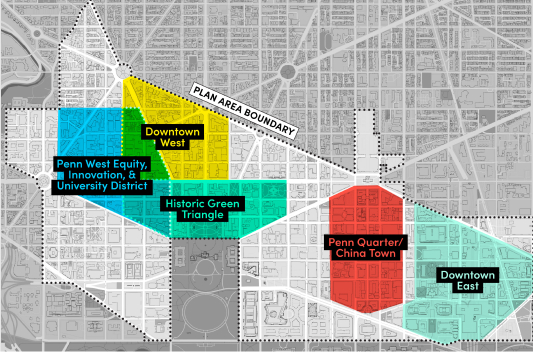
Key Nodes
Five Key Nodes represent specific locations within Downtown D.C. where distinct, place-based strategies can create significant demand and realize new value for the District, building on the successful implementation of the foundational elements.
In the following Foundational Elements & Nodes sections, items labeled as:
“Now” | FY 2025 budget priorities
“Near Term” | FY 2026 & FY 2027 budget priorities
“Future” | future priorities, once initial investments have been made
Historic Green Triangle
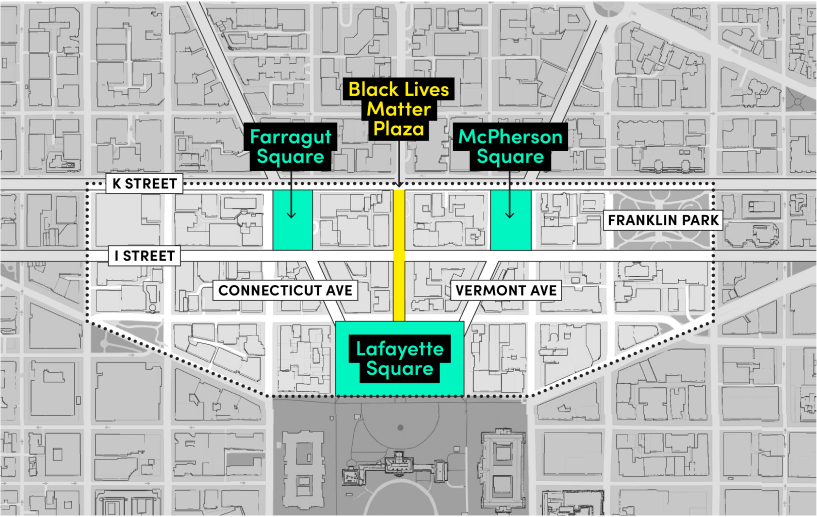
Revamp Farragut Square and McPherson Square, and connect these and other nearby parks and public spaces via a network of comfortable and pedestrian-friendly corridors to draw visitors off the National Mall and into Downtown D.C.
The area immediately north of the White House is likely the best opportunity to draw tourists into Downtown D.C. The vision of establishing a “history triangle” between Farragut Square, McPherson Square, and Lafayette Square reflects a unique strategy to transform this area into a true destination—one in which the quality of the public realm is commensurate with the extent of its civic importance. This strategy is highly synergistic with the visions for the Lush Greenway and Capital Promenade in the Public Realm Plan.
Now
- Implement improvements to Farragut Square, which are already funded, and take a leading role in the management of both Farragut Square and McPherson Square
- Fund design work to accelerate improvements to McPherson Square
- Implement the “first moves” for Lush Greenway from the Public Realm Plan, connecting Farragut Square and McPherson Square via a green boulevard along I Street
- Widen the sidewalks and calm vehicular traffic on the 800 blocks of Connecticut Ave NW and Vermont Ave NW, bolstering connections between Farragut Square, McPherson Square, and Lafayette Square, as well as dovetailing with the Public Realm Plan first moves for Capital Promenade and Neighborhood Street
Future
- Work with the National Park Service (NPS) to ensure renovations to Lafayette Square are synergistic with other public realm improvements Implement wayfinding and public art improvements along 15th Street, 17th Street, and other corridors with already-significant concentrations of visitors and tourists, to channel visitor traffic to the Historic Green Triangle
- Implement wayfinding and public art improvements along 15th Street, 17th Street, and other corridors with already-significant concentrations of visitors and tourists, to channel visitor traffic to the Historic Green Triangle
- Utilize public art and signage between Farragut Square, McPherson Square, Black Lives Matter Plaza, and Lafayette Square to create a “history triangle” for visitors, and implement further activations and improvements to then channel this visitor traffic into other parts of Downtown D.C.
- Create a model for a multi-modal urban promenade along K Street, including green spaces
- Work with property owners to create a retail plan (possibly including a master leasing program) focused on outdoor eateries, casual dining options, and locally made goods
Downtown West
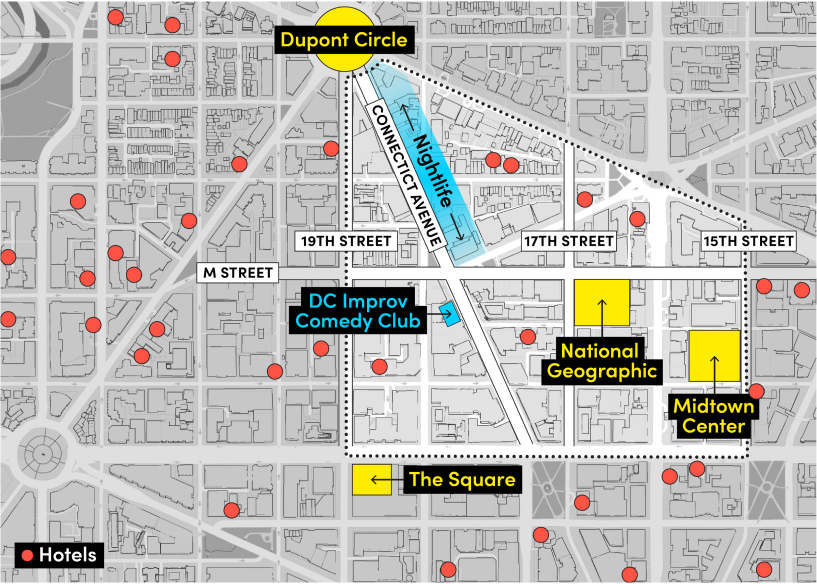
Create a new entertainment, hospitality, and cultural district to attract people from surrounding neighborhoods, by leaning into the National Geographic redevelopment and attracting a new entertainment venue in the Golden Triangle.
Downtown West offers several of the ingredients needed for a successful day and after-hours destination, with a robust supply of nightlife and hotel options. Recognizing this untapped potential, the following strategy aims to redefine the built environment and identity of Downtown West, not only by introducing cultural and entertainment elements, but also by strategically spreading these offerings to new areas of the node. In doing so, Downtown West can insert new life into areas that currently see little activity outside of business hours, such as 19th Street, M Street, and other areas south of Dupont Circle.
Now
- Complete a cultural master plan to guide the development of a new cultural district between 15th and 19th Streets, and to examine complimentary opportunities available in the broader Golden Triangle
- Develop a targeted block redevelopment plan for distressed assets in and around Downtown West, focusing on areas in which site assemblages are most feasible
Near Term
- Attract an entertainment/cultural anchor to the Golden Triangle and develop other cultural partnerships throughout the district; focus attraction efforts to the west of 16th Street, including along Connecticut Avenue, given the need for additional activation outside of business hours
Future
- Support the branding and marketing of this new cultural district and provide the tools for it to flourish, including targeted incentives for cultural production spaces (e.g., recording and rehearsal space)
Penn West Equity, Innovation, & University District
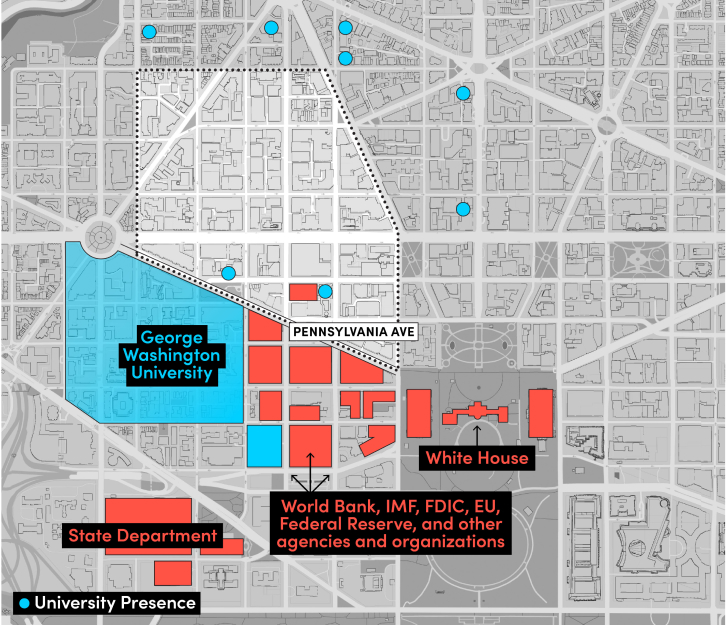
Grow Penn West as a hub for social sciences, technology, and policy innovation, with a robust network of startups and technology companies, top tier research universities, and workforce development programs.
With unmatched proximity to the White House, federal agencies, and global organizations, Penn West is ideally positioned to bring together public, private, and academic stakeholders to drive economic development in Downtown D.C. To catalyze this growth, Penn West must find innovative ways to backfill or reposition existing vacant office space, such as providing space for universities to co-locate, and launch accelerator and incentive programs that enable firms of all sizes to succeed.
Now
- Implement a soft landing program, and work with embassies and international institutions in the Penn West area to attract international companies
- Utilize the District’s new and expanded incentive toolkit—such as seed grants and subsidized office rent—to attract startups and entrepreneurs to Penn West
- Deliver the Penn West Global Innovation Hub, a physical space within the Penn West node that provides opportunities for early-stage firms to collaborate and cluster in place
- Attract top tier research universities to Penn West and create dedicated resources to maximize their economic impact
- Support ongoing operations and maintenance of parks in the Penn West Equity, Innovation, and University District, such as Edward R. Murrow Park and James Monroe Park
Near Term
- Complete Penn West streetscape improvements, which are already funded and construction ready, and implement international cultural and arts activations to help draw tourists from the White House
Future
- Create spaces for multiple universities to co-locate in one setting with shared amenities, thus encouraging greater collaboration and interaction between students and faculty
- Identify new development opportunities generated by university proximity, such as student housing, and market to property owners of buildings ripe for repositioning
- Establish a small business accelerator for District residents, building upon George Washington University’s Entrepreneur Development Network DC (EDNDC), to support emerging innovators from underrepresented communities.
Penn Quarter/Chinatown
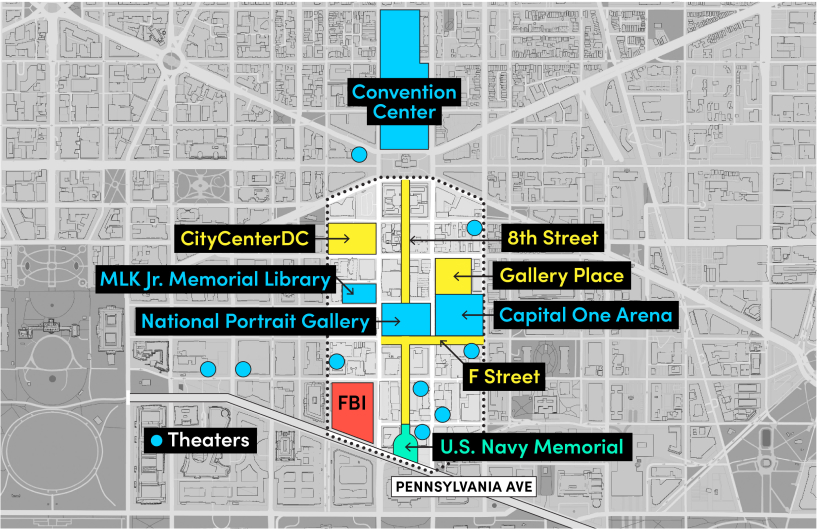
Improve the pedestrian appeal of 8th Street NW, and create new destinations for arts and culture, anchored by the Smithsonian’s National Portrait Gallery/Smithsonian American Art Museum and nearby theaters and performance venues with existing regional pull.
Penn Quarter / Chinatown is an existing cultural and entertainment district, so it provides an attractive location for new venues. While the December 2023 plans to relocate the Wizards and Capitals to Northern Virginia cast doubt over the future of Capital One Arena, Penn Quarter / Chinatown is an opportune location for place activations and cultural and arts district branding efforts to commence in full force once near-term challenges are addressed.
Now
- Continue negotiations to retain Capital One Arena and its teams; in the event the teams relocate, support the Gallery Place / Chinatown Task Force to establish a clear vision for the future of the site and support ongoing efforts to stabilize the neighborhood based on the needs of the community
- Support the branding and marketing of a cultural district, centered around Penn Quarter / Chinatown but also including surrounding theaters and performing arts facilities
- Calm vehicular traffic on the 400 and 500 blocks of 8th Street and create a play/recreation space between the Portrait Gallery and the U.S. Navy Memorial, as envisioned in the Public Realm Plan for Portrait Gallery Plaza: Cultural Commons; also consider pedestrian improvements along the 700 and 800 blocks of 8th Street to create an extended promenade from the Portrait Gallery to Mt. Vernon Square
- Transform the hardscape along F and G Streets between 7th and 9th Streets to allow for more frequent festivals and activations (e.g., Downtown Holiday Market), as recommended in the Public Realm Plan
- Reevaluate other pedestrian infrastructure in the node, particularly along 7th Street to bring it in line with the recommendations offered in the Gallery Place-Chinatown Corridor Study
Future
- Work with property owners to develop a retail plan (possibly including a master leasing program) for retail corridors currently experiencing elevated vacancy, incentivizing a breadth of food, beverage, and entertainment concepts that can appeal to residents and visitors alike
Downtown East

Support local universities and existing redevelopment sites and projects in order to integrate this area with the remainder of Downtown D.C., including using public property transfers and infrastructural improvements to create a more seamless urban fabric.
The existing landscape of Downtown East—often perceived as a latent “dead zone” in the urban fabric of Downtown D.C.—teems with potential for revitalization. As the canvas for mixed use development continues to expand, local universities can play key roles in establishing an interesting and more accretive mix of commercial, residential, and academic uses.
Now
- Support the Community for Creative Non-Violence (CCNV) with planning assistance to develop an alternative to its existing building on the adjacent parking lots owned by CCNV
- Establish Downtown East as a university district, and collaborate with Johns Hopkins University and Georgetown University to identify expansion opportunities
- Reposition public assets between the FBI Headquarters and Union Station, starting with a development of a plan for public property dispositions and long-term federal space needs
- Implement streetscape improvements along east-west throughfares to enhance the pedestrian experience for people traveling between Union Station and Downtown D.C.
- Plan and implement improvements to John Marshall Park and other parks in and around Downtown East, such as U.S. Tax Court Park and Cobb Park, that could increase opportunities for green space
- Support ongoing operations and maintenance of John Marshall Park and any additional redeveloped parks
Near Term
- Soften freeway on-ramps and exit ramps to ensure more comfortable pedestrian paths and enhance pedestrian safety
- Implement improvements to Louisiana Avenue to bolster connectivity between Union Station and the National Mall, allowing Downtown East to attract greater visitor traffic
Learn More
Download the Downtown Action Plan for more details.